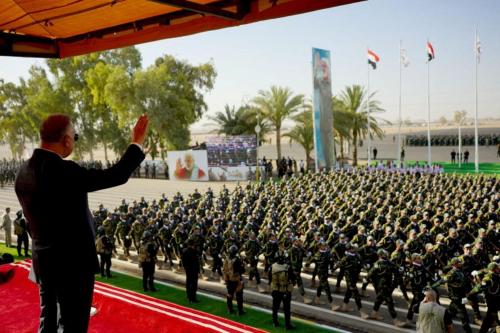Two spectacular al Qaeda prison breaks in Iraq, freeing over 500 of its members in two separate prisons simultaneously this week, demonstrate the group is back with a vengeance. Al Qaeda’s Iraq branch is also the moving force behind the jihadist success in Syria. The resurgence of al Qaeda in Iraq has sobering implications for what is likely to follow the drawdown of NATO forces in Afghanistan for the al Qaeda mother ship in Pakistan.
The double jailbreaks at Abu Ghraib and Taji prisons were massive attacks. Suicide bombers, teams of attackers using mortars and small arms, and two dozen car bombs were used. The firefight killed over a hundred Iraqi guards. The attackers also had inside help within the Iraqi security forces. The attacks were the culmination of what al Qaeda in Iraq’s leadership had promised a year ago when it launched the “Breaking the Walls” offensive to free its prisoners from Iraqi jails.
Al Qaeda in Iraq, or the Islamic State of Iraq and the Levant, as it is officially named, was created by Abu Musab al Zarqawi in the wake of the American invasion of Iraq in 2003. A Jordanian, Zarqawi had worked with Osama bin Laden in Afghanistan before 9/11 and built many connections in Iraq in the months before the war. Within months of the occupation, his terror gang was killing American troops and Iraqi Shia and taking the country to civil war. Bin Laden publicly anointed him al Qaeda’s amir for the entire region including Iraq, Syria, Jordan, Lebanon, and even Turkey.
Zarqawi was hunted down and killed by American forces in a brilliant operation led by Gen. Stanley McChrystal in 2006. His successor was killed a year later. But as McChrystal has said publicly, it was too late. By the time U.S. forces killed Zarqawi, the group had become deeply embedded in Iraqi Sunni Arab society. It was harshly repressed during the American surge, but it was never really defeated. It began to regenerate as soon as American forces left Iraq.
So far this month al Qaeda terrorist attacks have killed over 500 in Iraq. Its leader today, Abu Bakr al Baghdadi, promises many more deaths.
At the same time, al Qaeda in Iraq has been the moving force behind the birth and growth of al Qaeda’s franchise in Syria. One of Zarqawi’s protégés, Muhammad al Golani, was sent by al Qaeda in Iraq to set up the al Nusra Front in 2011. By mid-2012 it had become one of the most effective groups in the Syrian opposition movement to Bashar al-Assad’s government. It got considerable support in money, arms, and men from the Iraqi front.
Now al Qaeda in Syria is getting hundreds of volunteer fighters from across the Islamic world, all coming to join the struggle. This week Dutch police arrested a 19-year-old Muslim girl in The Hague who was helping to organize the recruitment and movement of Dutch Muslim citizens to Syria to join the al Nusra Front. Dutch sources say over a hundred have already gone. In Pakistan, the al Qaeda–affiliated Taliban says it is sending fighters to join the battle in Syria and support al Qaeda. Syria has become what Afghanistan, Bosnia, and Iraq were to earlier generations of jihadists: the epicenter of the global jihad. From Western Europe to Southeast Asia, the networks that shipped fighters to Iraq a decade ago are now sending them to Syria.
The al Qaeda group has also begun spreading its influence into Lebanon as well. One well-informed observer reports that “from Tripoli to Akkar, and from Sidon to the heart of Beirut, black Salafi-jihadi flags and banners have been spotted in increasing numbers, a picture unseen before in Lebanon’s history.” The Shia Hezbollah’s support for Assad is creating an all-too-predictable backlash of support for al Qaeda and other extremist Sunni groups inside Lebanon.
Over the objections of al Golani, the Iraqi al Qaeda leadership has insisted it is in charge of the entire al Qaeda movement in the Fertile Crescent states, arguing it has inherited the mandate that bin Laden gave to Zarqawi a decade ago. Bin Laden’s successor, Ayman Zawahiri, has sided with al Golani and wants the two groups kept separate, each reporting to him. Al Baghdadi is proving as independent and difficult to manage as Zarqawi was in his heyday, when he too defied Zawahiri’s injunctions to be more restrained in his attacks on Shia targets.
The regeneration of al Qaeda in Iraq and its spread into Syria and Lebanon has important lessons for dealing with al Qaeda in South Asia. In the last five years President Obama has made considerable gains in disrupting and dismantling the al Qaeda core leadership in Pakistan, as he promised he would. Bin Laden’s death, and the death of many of his key lieutenants by drones, has put the mother ship of al Qaeda on the defensive. But it too is not defeated.
Al Qaeda in Pakistan is embedded in a deep network of support groups, including the Taliban and Lashkar e Tayyiba, which help protect it and give it sanctuary, especially in cities like Karachi. It is under virtually no pressure from the Pakistani government. The government’s own secret investigation of how bin Laden lived for almost a decade inside Pakistan before the SEALs delivered justice concludes that the Pakistani intelligence service, ISI, is either hopelessly incompetent or complicit in working with al Qaeda.
All of which means that if American pressure on al Qaeda in Pakistan diminishes after the NATO withdrawal of combat forces next year from Afghanistan, we can expect a rapid regeneration of al Qaeda in Pakistan. The drones all fly from bases in Afghanistan, without which there is no pressure on al Qaeda next door in Pakistan. Iraq is a sobering lesson in what happens when a battered al Qaeda movement gets a second chance.



Commentary
Op-edAl Qaeda Is Back
July 26, 2013